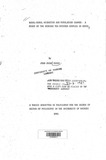| dc.description.abstract | This study explores, the nature, pattern/and
implications for rural development of rural-rural migration
which, unlike the rural-urban component, remains a
relatively virgin area of internal migration research:
as well as analysis in contemporary Kenya. It focuses
attention on Western Kenya which ranks as one of the
principal out-migration areas in the country; and is, for
once, a weIcomedlstract.i on from the more often studied
/
rural-urban migration from which some ques tionable
insinuations about the former generally enanate . Western
Kenya in the context used here corep ri ses eight districts
of thedefunct Nyanza Province prior to 1962: Kisii,
Kisull1u, Siaya and South Nyanza which make up Nyanza
Province; Bungoma, Busia and Kakamegawhich constitute
Western Province; and Kericho District in Rift Valley
Province.
In physical and human environmental contexts, Western
Kenya is a most distinctive geographical cumpopulation
entity exhibiting some conspicuous environmental problems
often generating out-migration with which the region is
associated. Even wi thi n the region itself, rural-rural
migration of considerable le spatial-temporal significance
occurs between these districts and the Kericho tea estates
complex situated in the only in-migration district here.
However, the longs tanding dominance of the tea complex is
increasingly being challenged by other emerging economic
islands of development in the region, notably the fast
-.... r... ••
mushrooming sugar industry which reflects economic
renaissance envisaged: in rural industrialization programme,
Contemporary migration literature is replete with
analysis of rural-urban migration at the expense of
rural-rural migration which, together with the fanner,
are representative of the present phase of ' the
"mobility 'transition'~_ This hypothesis, attributed to
Wilbur Zelinsky, enr.i.ches the "demographic transition theory"
l'w1:richconfines itself to fertility - IIDrtality changes "
and, like the latter, shows the dichotomy of migration types
between the developed and the developing countries ,
Literature reviewed suggests that analysis of rural-rural
migration is long overdue.
Based on a sample survey of the Kericho tea estates
complex, the study makes findings and draws conclusions that
contrast appreciably with those with which students
of migration are familiar in rural-urban migration studies.
A total sample of 944 respondents was dra from a
stratified random sampling design comprising 585 males,
the bulk of whom are heads of households, and 359 females,
primarily married females aged 15-49 years. Statistical
testing of these primary data, using analysis variance
and non-parametric tests suc~ as t-test, suggest that no
significant difference exits ts between the two blocks of '
tea estates - the Brooke Bond Liebig Kenya Limited (BBLK)
and the African Highlands Produce Company(AHP), and that
the data are both viable and dependable enough for making
rational inferences about the entire migrant population.
Besides, secondary data, mainly cepsus data, have been
included to supplement the foregoing and to facilitate
some comparisons. By using appropriate statistical and
demographic techniques, objective interpretation of the
data has been obtained.
The migration field of th is rural rura I migration
process is basically threefold. Fir~'t'- the core is Western
Kenya itself 'which constitutes the primary and most
important source area of migrants. The dominance of
farther than nearer districts, due to historical and
other peculiar factors, defies conditions expected to
be fulfilled by theoretical assurrptions. Second, the
Immediate fringes of this core, made up of contiguous
districts in Rift Valley Province, mainly marginal areas
where a hostile environment triggers out-migration.
Third, a small but significant proportion of international
migrants originate from neighboring lacustrine Uganda
and Tanzania and as far' _ afield as Rwanda whose
migrants out number those from the two count.r.i.es. In the
process of analysis, emphasis is placed on internal migrants,
5pecially those from the core migration field.
Analysis of the determinants of rural-rural
migration rarely corroborates the stereotyped findings
of rural-urban migration studies. For example , a vicious
circle of regionally significant "push" factors underscores
the determinants relevant in the study area; distance,
though as inversely related with migration as in rural urban
migration, has but a weak influence and, in isolated
cases, is irrelevant; and non-economic factors, SUdl as the
presence of relatives/friends ensures both reliable .information
about job prospects as we11 as a ready refuge for prospective
migrants . But the overriding impact of economic factors
is ascertained. A nunber of applied migration node Is -
spatial interaction and socio-economics - are found to
be more theoretically fascinating than empirically convincing.
Therefore, the rural-rural migration ffi0del constructed
here incorporates both some stereotyped and a new set of
factors recognized in this study.
The study recognizes that migration and aggregate
population change have adverse consequences in out-migration
areas compared to positive ones in-the- tea estates complex.
This situation, it is ar~ed, is likely to be altered
by several measures for regulating adverse aspects of
population change, amounting to either eliminating outmigration
or encouraging intra-regional migration, or both.
iv
The conclusion drawn from the study is that
increasing attention should be directed to rural-rural
migration in order to have a more complete ins ight of
contemporary internal migration, and one likely to
persist in the foreseeable future. Consequently, it
is argued that a meaningful policy on migration must of
necessity be formulated only after the stock and fl~vs
of this migration process are articulated in the context
of rural development. | en |

